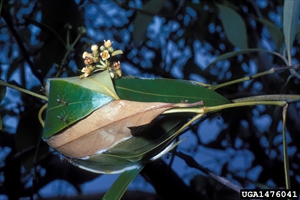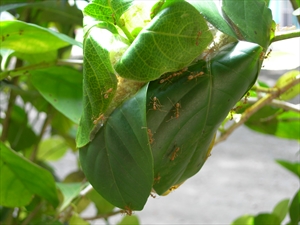Green weaver ant. It is also known as the green tree ant.
Pacific Pests, Pathogens, Weeds & Pesticides - Online edition
Pacific Pests, Pathogens, Weeds & Pesticides
Green weaver ant (386)
Oecophylla smaragdina
East and Southeast Asia, Oceania. It is recorded from Australia, Papua New Guinea, and Solomon Islands. Similar species occur in Africa.
Oecophylla ants feed on small insects, and tend aphids, mealybugs and scale insects for their honeydew.
The ants vary in colour depending on locality (Photo 1); some pale yellow, others reddish to yellow-brown. The ants live in trees where they build nests (300-500 mm long), bringing leaves together and fasten them with silk from larvae – silk that is used for construction of cocoons before pupating (Photos 2-5). Even large nests are constructed within 24 hours. Colonies may have hundreds of nests in groups of trees containing more than half a million individuals. After a nuptial flight, queens lay eggs on a leaf and tend the larvae and pupae that develop into workers. A single queen inhabits one nest (in Australia it can be several) and its eggs are distributed to other nests in the colony. Worker ants are ‘major’ (8-10 mm) and ‘minor’ – half that length. Majors forage for food, defend and expand the colony (Photo 1); minors stay within the nests, caring for the young, and tend other insects for honeydew close by. Unfertilised eggs become males.
Oecophylla ants do not sting, but can bite, and often spray formic acid on the wound causing irritation or pain.
Communication between these social insects uses pheromone trails, touching and even carrying individuals to where they are needed.
Oecophylla smaragdina is effective in controlling over 50 species of insect pests (e.g., sap-sucking bugs, beetles, caterpillars, thrips, and fruit flies) on many tropical tree crops (e.g., cashew, citrus, cocoa, coconut, lychee, mango, oil palm) and forest trees (e.g., African mahogany, eucalyptus, and hoop pine).
Look for nests of leaves fastened together with silken threads. Look for relatively large, light brown ants that move quickly, and fiercely defend their nests when disturbed.
NATURAL ENEMIES
Oecophylla ants have few natural enemies. There are jumping spiders and a butterfly, Liphyra brassolis, in Australia, whose caterpillar eats Oecophylla larvae.
BIOSECURITY CONSIDERATIONS
Although there are instances of the effectiveness of the weaver ants controlling pests in a number of economically important crops, these examples are not to suggest it should be introduced to countries where it is absent. A pest risk assessment that considers the economic and environmental consequences of such introductions should always be carried out and decisions made with utmost caution.
USES AS BIOCONTROL AGENTS
Examples of using Oecophylla smaragdina in integrated pest management programs:
- Farmers in Southeast Asia (particularly China and Vietnam) have used these highly territorial ants as natural biocontrol agents in citrus orchards for hundreds of years. Nests are moved into trees, and canes or rope linked to adjacent trees to aid foraging and spread.
- Weaver ants can effectively control all four major pests of cashew: the tea mosquito bug, Helopeltis; the mango tip borer, Penicillaria; the fruit spotting bug, Amblypelta; and the leafroller, Anigraea, in Australia, resulting in increased profits and nut quality.
- In mango, in the Northern Territory, Australia, where seed weevil (Sternochetus mangifera) is a problem, damage was less than 1% of fruits with ants, compared to 2.5-16% without ants, and 1-2% with insecticide. Similar beneficial results have been reported against the mango leafhopper (Idioscopus nitidulus) and also the red-banded thrips (Selenothrips rubrocinctus) in the Northern Territory.
- Farmers in East Africa collect colonies of Oecophylla enclosed in their nests, placing them in plastic containers hung at the top of orange trees. This is done at flowering. Oecophylla attack fruit flies (Bactrocera zonata, Bactrocera cucurbitae, and Bactrocera dorsalis) when they arrive to lay eggs.
- Experiments in Australia suggest that by controlling pests in African mahoganies there are 40% fewer trees with multiple leaders. The ants forage on extrafloral nectaries, prey on pest larvae, and repel adult pests preventing feeding and laying eggs on shoot tips.
- Attempts to use Oecophylla to control Amblypelta (coconuts and cocoa) and Pantorrhytes (cocoa) in Solomon Islands and Papua New Guinea (see Fact Sheets 19 and 66) have been less successful. The introduction of trees that attract scale insects and mealybugs, i.e., soursop and citrus, increase chances of successful establishment of Oecophylla colonies, but the main problem is competition from other ant species.
ADVANTAGES & DISADVANTAGES
Advantages from using the ants are (i) less damage to the trees, (ii) higher quality fruit and (iii) lower pesticide use. Disadvantages are that scale insects and their relatives are protected from natural enemies, the ants may reduce numbers of pollinating insects, and interrupt seed dispersal by mammals and birds. Minor blemishes on mango fruits have been reported from formic acid burns, and less noticeable anal spots. The major disadvantage from using Oecophylla smaragdine in IPM programs still seems to be their aggressiveness and willingness to bite when farmers are collecting colonies or harvesting fruit.
AUTHOR Grahame Jackson
Information from Antweb. (https://www.antweb.org/description.do?genus=oecophylla&species=smaragdina&rank=species); and Weaver ant. Wikipedia. (https://en.wikipedia.org/wiki/Weaver_ant); and Repelling fruit flies by weaver ants in oranges. Plantwise Factsheet for Farmers. Plantwise Knowledge Bank. (https://www.plantwise.org/KnowledgeBank/FactsheetForFarmers.aspx?pan=20157800369); and from Peng R, Christian K (2007).The effect of the weaver ant, Oecophylla smaragdina (Hymenoptera: Formicidae), on the mango seed weevil, Sternochetus mangiferae (Coleoptera: Curculionidae), in mango orchards in the Northern Territory of Australia. International Journal of Pest Management, 53(1), 15-24. Photo 1 Muhammad Mahdi Karim Red weaver ant, Oecophylla smaragdina in Bangalore, India. (https://en.wikipedia.org/wiki/Weaver_ant#/media/File:Red_Weaver_Ant,_Oecophylla_smaragdina.jpg). Photos 2&3 Howard Ensign Evans, Colorado State University, Bugwood.org. Photo 4 Basile Morin Nest of Oecophylla smaragdina (weaver ants), made of green leaves welded together. (https://commons.wikimedia.org/wiki/File:Nest_of_oecophylla_smaragdina_(weaver_ants).jpg).
Produced with support from the Australian Centre for International Agricultural Research under project HORT/2016/18: Responding to emerging pest and disease threats to horticulture in the Pacific islands, implemented by the University of Queensland and the Pacific Community.








